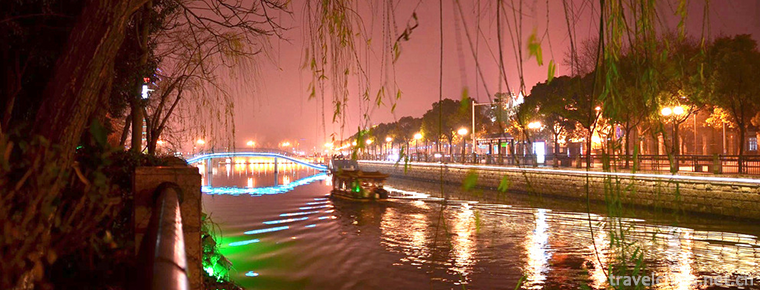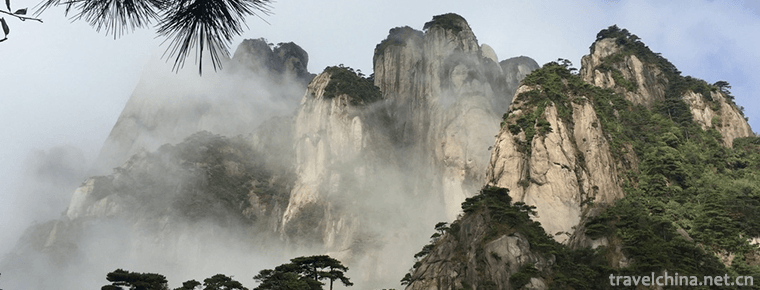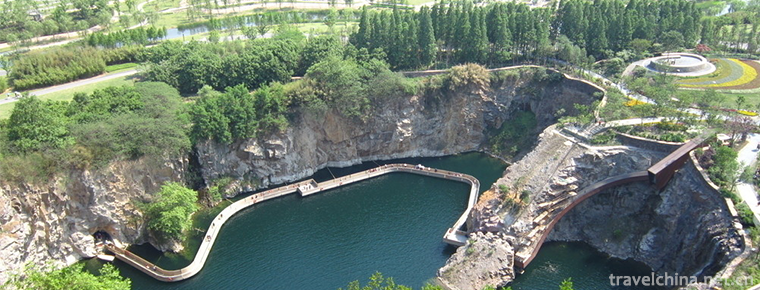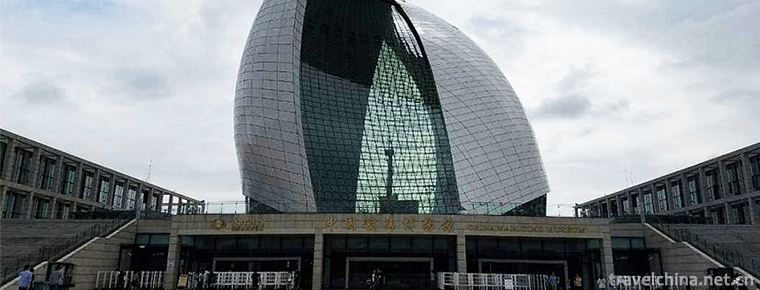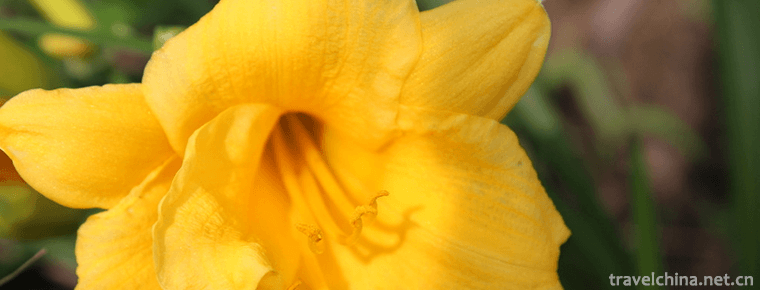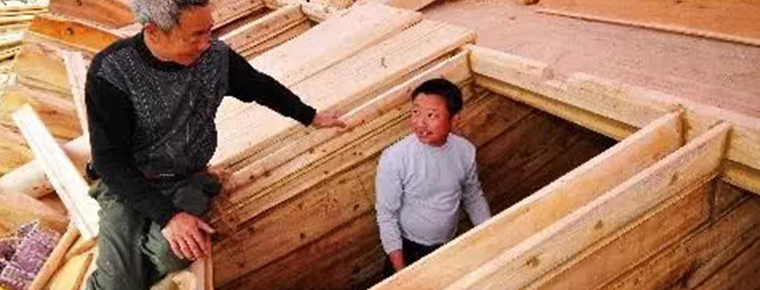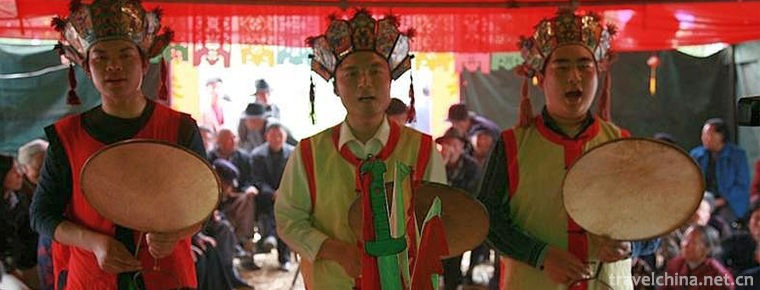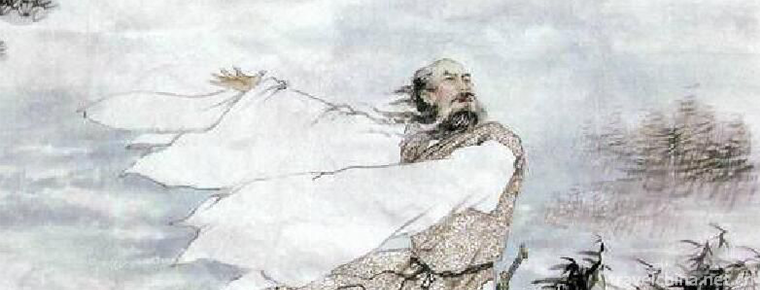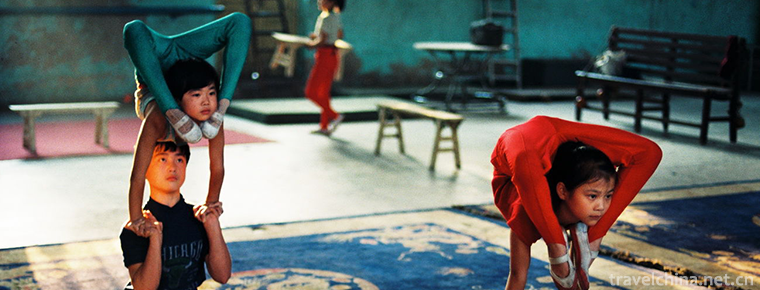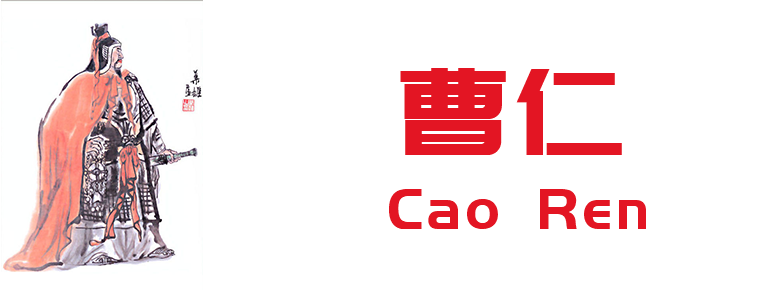Flower hopping shed
Flower hopping shed
Dancing Huapeng, introduced from Fujian in Ming Dynasty, is an ancient traditional folk dance, belonging to Nuo dance. It has a fixed "Keben" (singing desk book), which is divided into 18 branches (fields) such as receiving gods, seats, open shed doors, children, Tao Shu, Xiu Cai, later generations singing, Yiqian, Chen Jiu, hoeing fields, etc. It mainly expresses farming, men and women's feelings, and life interesting talk, aiming at dispelling evil, praying for smooth weather, material prosperity and people's peace, and Wugu Fengdeng.
On May 23, 2011, the vault was approved by the State Council and listed in the third batch of national intangible cultural heritage list.
Historical Origin
Huazhou area of Western Guangdong, "Dance shed" is also known as Dance shed dance, is a kind of Nuo dance wearing masks when performing. It originated in Fuzhou, Fujian, and spread to Huazhou in the late Ming Dynasty.
The dance was once introduced to Ronggen and Changweigong villages in Huazhou and passed on from generation to generation. However, due to various objective reasons, the dance was lost in other villages, and only Changwei Gong Village inherited it. According to the local chronicles, the people of Huazhou in the Ming and Qing dynasties danced in the shanty bars outside Xiangguangmen. The urban and rural society chooses good singers, wears children's puppet clothes and puppet towels, sings and dances with bells at night, plays drums and slowly steps up and down the altar. This kind of activity is commonly called "Nuo Dance".
The master was Chen Baoxue and Li Desheng from Guanqiao Town. Following to the Song and Wu clans, the masters were Zhu Jihe and Wu Deutsche. Then introduced to the Changwei Gongcun family, the master is Yao Jihu, Yao Fenghu. Yao family moved from Dajingtou village of Shizhu Machine Lane, Puchang County, Fuzhou City, Fujian Province, to Changsha village, Nan'an, Huazhou (once called Ronggen village), and then to Changweigong village. According to the veteran artist Yao Tong (born in 1905, the twenty-first generation heir), in memory of their ancestors, the villagers once named the village "Chen Li Gong Village", orally called "Chen Mei Gong Village", and later called it "Long Tail Gong Village".
"Flower-hopping shed" is usually in the "light snow" and "heavy snow" season (that is, October of the lunar calendar), villagers choose "Eating Day" to perform once a year in designated places, each time for one day, just like the "annual festival" generally grand. According to Maoming City Chronicle, "Year" is unique to villages in Jianjiang and Luojiang valleys in Western Guangdong, and it was very popular in Qing Dynasty. It is an activity of worshiping gods, traveling gods, offering sacrifices to the gods, praying for good weather, prosperity of all trades and national security. It is actually an expanded Spring Festival, Lantern Festival, temple fairs, including ancestor migration and footfall anniversary, and other comprehensive festivals. There is a proverb in Western Guangdong: "Winter Solstice (Winter Solstice) Spring Festival (Spring Festival)". The proverb of Huazhou is "jumping shed (jumping flower shed) overwinters", "marrying long tail father, eating jumping shed and then eating winter". It can be seen that jumping flower shed is a very important local folk activity. In the process of exploring the "vault", the author finds that traditional and current venue layout, performance form and performance content have developed and changed.
Stylistic features
(1) The performance form and style of the traditional "vault". The traditional performance form of "Dancing Huapeng" is a typical Taoist activity. It is recorded in the Chinese Folk Dance Integration: Guangdong Volume that "Dancing Huapeng" appears in the form of "Nuo Opera", and its mask is similar to the figure shape of opera, performing according to eighteen fixed "Keben" (phonograph). Among them, when "receiving divinity" and "setting up divinity", burning incense to worship, chanting scriptures are very similar to the form of "wandering gods" in the rural New Year celebrations every year. The traditional performance style of "jumping flower shed" can be described as rugged, concise and humorous exaggeration.
(2) The present performance form and style of "vault". At present, "vault" has evolved from performing on designated vault slopes and vault platforms to performing on stage squares. The performance venue has changed, and the performance form has also changed synchronously. The performance form of "Dancing Flower shed" has no connection with Nuo (religious activities), but more reflects its dance art form. The performance form is also staged, which forms the performance form of dance art. In terms of style characteristics, artists advocate retaining the performance style characteristics of "jumping flower shed".
Performance Content
(1) The performance content of the traditional "jumping flower shed". On the day of "Eating Art Day", the performances were performed in accordance with the fixed textbook order of "Jumping Flower shed": receiving gods, settling down, opening shed doors, children, Dao Shu, Xiu Cai, later generations singing, before, Chen Jiu, hoeing, fishing, judges, prisons, delivering insects, measuring shed, eight immortals, dismantling shed shed, one-legged monks and so on.
Every subject of "Jumping Flower shed" has certain implication and performance content, such as "Dao Shuke" is played by six kinds of Nuo masks, including Dao Gong, Sand Knife, Rake Head, Mug Gun, Paper Money and Axe, of which "Dao Gong" is performed by two people and seven people. First, two "Dao Gong" jumped out with one hand, then sand knife, rake head, reeling gun, paper money and axe also appeared in sequence. The movements included "throwing inside and outside", "kneeling fight", "turning around and supporting gills", "throwing fruits in disorder", "pointing to the moon", "grinding valley", "chopping hands", "kicking the ball" and "flower arranging". Each action was jumped in four directions, commonly known as "jumping". Four doors"). After jumping on the ground, seven actors went up to the jumping platform and squatted down to repeat their movements. This time they were called"Uncle Changdao". It mainly expresses the will of exorcising evil spirits and avoiding disaster, praying for peace and welcoming good fortune. "Xiu Caike" mainly expresses the wish to cultivate more sages and sages; the "post-natal singing section" mainly eulogizes the life interest and emotional content; "Chen Jiuke" also expresses the desire to dispel evil spirits and suppress evil spirits; "Hoe the fields" and "Fishing Section" mainly express the joy of production labor, farming process and harvest.... From the above statement, it can be seen that the performance content in the traditional "jumping flower shed" is mainly to pray for God, bless peace, exorcise evil town, welcome auspicious luck, Wugu Fengdeng, six animals prosperity and other good wishes.
(2) The present performance content of "Jumping Flower shed". Local artists improve the performance content of "jumping flower shed" according to the three principles of "straightening out and concentrating, drawing lessons from integration, increasing or decreasing flexibly" of folk art.
1. Straighten out the concentration. Because many subjects of traditional "jumping flower shed" have feudal superstition, artists simplify the content of performance from the original "eighteen subjects" to only retain several subjects of high artistic value such as "hoeing field" and "Dao Shuke" at present, and the rest of the subjects have been deleted. The performance time was reduced from one day to ten minutes.
2. Drawing lessons from integration. Based on the six roles of Dao Shuke's Nuo masks, this paper integrates the action materials of classical dance, draws lessons from choreography techniques, enriches the expressive force of dance, and makes the performance content of "Flower Dance shed" diversify into art.
3. Increase or decrease flexibly.
The improved "flower hopping shed" has flexible role configuration. According to the content of the play, the creator appropriately increases or decreases the number of roles (masks), props and actors. The content of the performance is still based on the harvest of labor, the interest of life and love stories, without changing the traditional style of "jumping flower shed".
Action Form
Flower hopping shed Atlas
(1) The dance form of "flower shed" has a great origin with "Nuo".
Documents and pictures about Nuo dancing all over the country, such as Fujian Shaowu Nuo Dance, Zhanjiang Wuchuan Nuo Dance, Jiangxi Le'an Nuo Dance, and the "flower shed" successor, Mr. Zhang Zhenqian, Vice Director of Cultural Bureau of Yuanhua City, demonstrated "kneeling Dou" and "flower shed" folk artist Yao Maotai demonstrates "chopping hands", through these different areas of Nuo Dance pictures, the author summarizes: In the Nuo dance pictures of different regions, the actors all do the same action - the big eight-character half squat horse step. "No horse step is no nuo", and horse step has become an important feature of Nuo dance art.
The horse step is the most basic step in practicing Wushu. It is named for its posture as riding horse and stake-like stability. Dancers should have their feet slightly wider than their shoulders and half squat posture. The horse squats well, and can be stably discharged. It has good balance and is not easy to be knocked down. Squatting horses should be deep, flat and steady. The author believes that the main reason why Nuo dance adopts horse step as its basic footwork is that it pays attention to the characteristics of "stability". Because of the horse step, the "vaulting shed" has formed the rhythmic characteristics of "stability" and "sinking". "Nuo is a cultural phenomenon of inviting gods to chase ghosts and praying for good fortune and disaster relief." "Nuo means expelling pestilent ghosts." Nuo is a kind of sacrifice popular in the Central Plains in ancient times. Its purpose is to drive out ghosts and epidemics, pray for good luck and disaster relief, and protect peace. As far as its form and function are concerned, Nuo is a kind of exorcism and witchcraft.
Nuo and "expelling pestilent ghosts" have been mentioned many times in the book. To expel pestilent ghosts, there must be righteousness and evil spirit in order to suppress ghosts and expel pestilent ghosts. The process of Nuo jumping is a process of fighting with ghosts. The horse trot has the advantages of stability, strength and ease of advance and retreat. It is not easy to overthrow and has a certain momentum of victory, and eventually expels the epidemic ghosts. As a kind of Nuo dance, "flower shed" obviously has the common characteristics of Nuo dance. No matter what action "vault shed" does, it mainly takes horse steps, but the range of horse steps is relatively small. Without changing the movement posture, it can only jump up and move on two feet, so "pedal" and "jump" constitute the basic movements of "vault shed". In the action description of "Integration of Chinese Ethnic and Folk Dances: Guangdong Volume", the form of "Big Eight-Character Step and Half Squat" has been emphasized many times, which is what we call "Horse Step". The book also emphasizes the verbs "pedal" and "jump" many times, which are the basic rhythm of the horse step.
It can be seen that "jumping flower shed" has a great origin with Nuo. The Basic Footwork of "jumping flower shed" is horse step, forming the basic rhythm and basic movement form of "stable, sink, pedal and jump" of "jumping flower shed".
(2) The similarities and differences between the traditional dancing hut and the current dance noumenon. The current "vault shed" is improved and innovated on the basis of retaining the traditional morphological characteristics.
Therefore, there are many similarities and differences between tradition and the present. There are two similarities: (1) The basic body movements and rhythms formed by the basic footwork and horse steps are the same as those of "steady", "sink", "pedal" and "jump", which are also the common features of Nuo dance. (2) Most hand positions and movements remain unchanged. Such as "palm-spreading", "palm-pressing", "kneeling fight", "turning around to support the cheek", "leaving out", "sharpening knife", "kicking ball", "sharpening knife" and so on.
Differences: 1. Traditional dance movements of "flower shed". Yao Maotai, a folk artist, taught the author the most primitive action of the traditional "jumping flower shed". As the only old folk artist alive, his most important task is to preserve and inherit the original action of the "jumping flower shed". This set of movements is mainly based on "Dao Shuke" such as "kneeling fighting", "chopping hands", "wrapping horns", "pointing to the moon", "grinding valley", "sharpening knife" and thirteen other movements. See "Chinese Folk Dance Integration: Guangdong Volume" for basic instructions. 2. The current dance movements of "dancing flower shed".
In the repertoire, it was found that there were only two steps in the dance: the horse step and the back kick. In the traditional "vault shed", only the horse step is a kind of footwork, and retaining the horse step can retain its ontological characteristics. The horse moves steadily, but its range of movement is small and its range of mobility is small. As for the back kick, from the point of view of dance art, the author considers that the back kick is a flexible and mobile footwork. It is not the movement of the main form of "vault". The biggest reason for adopting it is to meet the needs of the stage, increase the fluidity of dance and increase the beauty of dance.
In addition to traditional dancing movements, most of the new movements are based on imitating real work, such as hoe and hoe; sickle cutting rice; these movements are not in the traditional "flower hopping shed", adding them in order to increase the expression of dance.
Current status of protection
In 2011, it was listed in the third batch of national intangible cultural heritage
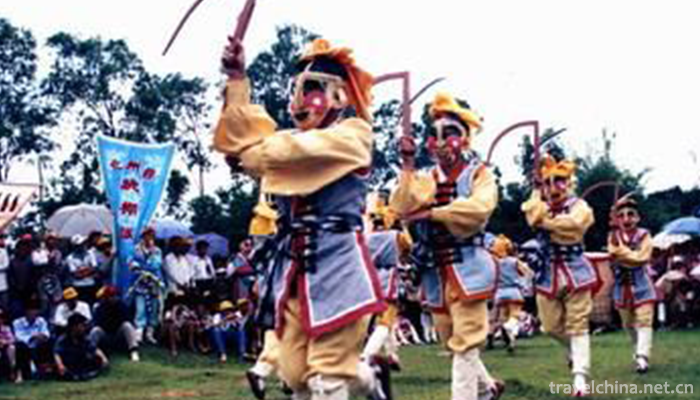
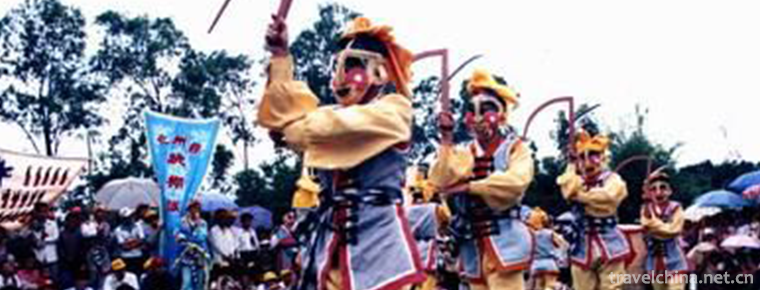
Flower hopping shed
-
Hao River
Haohe River surrounds the old city of Nantong, like a gourd, like a Pearl chain, known as the "emerald necklace" of Nantong City. It is a national 5A tourist attraction.
Views: 212 Time 2018-12-06 -
Sanqing Mountain Scenic Spot
Sanqing Mountain, also known as Shaohua Mountain and Yashan Mountain, is located at the junction of Yushan County and Dexing City, Shangrao City, Jiangxi Province
Views: 214 Time 2018-12-08 -
Shanghai Chen Shan Botanical Garden
Shanghai Chenshan Botanical Garden is located at 3888 Chenhua Highway, Songjiang District, Shanghai. It was opened to the public on January 23, 2011. It was built by Shanghai Municipal Government in c
Views: 185 Time 2018-12-19 -
China Maritime Museum
China Navigation Museum, fully known as "Shanghai China Navigation Museum", is the first national navigational Museum approved by the State Council. It is co-constructed by the Ministry of T
Views: 153 Time 2018-12-22 -
Hainan Tropical Wildlife Park and Botanical Garden
Hainan Tropical Wildlife and Botanical Garden is a national AAAA-level tourist attraction with the theme of popular science exposition, conservation and reproduction, sightseeing, leisure and vacation
Views: 273 Time 2019-01-13 -
Traditional Wooden Ship Manufacturing Techniques
Fuyang has a long history of shipbuilding. As early as the Tang Dynasty, water transportation was glorious. Fuyang Lingqiao wooden boats are mainly distributed in towns along the Fuyang River, especia
Views: 357 Time 2019-04-21 -
End drum cavity
Weishan Lake Drum Tune, also known as Duangong Tune, is a traditional folk art of the Han nationality originating in Weishan County and Dongping County of Shandong Province
Views: 229 Time 2019-04-28 -
The Dragon Boat Festival
Dragon Boat Festival, also known as Dragon Boat Festival, Double Boat Festival, Midday Festival, Dragon Boat Festival, Zhengyang Festival, Bath Orchid Festival, Tianzhong Festival,
Views: 111 Time 2019-04-28 -
Liaocheng acrobatics
Liaocheng acrobatics is a traditional folk acrobatics art in Shandong Province. Liaocheng is one of the birthplaces of Chinese acrobatics. In the late Neolithic period, Liaocheng was the main area whe
Views: 178 Time 2019-05-13 -
Brewing Techniques of Shaoxing Yellow Rice Wine
Shaoxing has a long history of brewing wine, which can be traced back to the Spring and Autumn Period and the Warring States Period. By the time of the Northern and Southern Dynasties, it was well-kno
Views: 181 Time 2019-06-14 -
Cao Ren
Cao Ren (168 - 23 May 6th), Zi filial piety, Han nationality. Pei country Qiao (today) Anhui Cao Cao, Bozhou From younger brother (from ancestor). The famous heroes of the Three Kingdoms period.
Views: 186 Time 2019-09-15 -
Plant resources in Meishan
There are 2278 species of wild plants belonging to 861 genera and 229 families in Meishan City, including 149 species of bryophytes belonging to 71 genera and 48 families, 155 species of ferns belonging to 73 genera and 36 families, 20 species of gymnosperms
Views: 379 Time 2020-12-18
